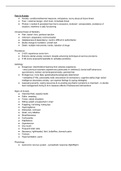Pain & Anxiety
● Anxiety: conditioned/learned response, anticipatory, worry about ptl future threat
● Fear = external danger, short lived, immediate threat
● Phobia = marked & persistent fear that is excessive, irrational / unreasonable, avoidance of
situation, interferes w daily functioning
Universal Fears of Dentistry
● Pain: doesn’t hurt, painless injection
● Unknown: preparatory communication
● Helplessness & dependency: control, difficult in authoritarian
● Bodily change & mutilation: overall look
● Death: multiple instruments, hands, injection of drugs
Prevalence
● 2-42% experience some form
● Extreme dental anxiety constant, despite advancing techniques & service provisions
● F>M (more anxious/honest/able to verbalise emotions)
Aetiology
● Exogenous: direct/indirect learning from adverse experience
- direct previous traumatic experiences (particularly in childhood), dental staff behaviours
(punishment), indirect via family/peers/media, parental fear
● Endogenous: more likely genetically/physiologically determined
- heritability (F>M), personaility traits (neuroticism & introversion), cognitive ability (high verbal
intelligence decreases anxiety, can express feelings & coping strategies)
● Assessing severity, coping resources & co-existing psychiatric symptoms is important - to decide
best management during tx & to measure effects of behavioural interventions
Signs of Anxiety
● Clenched fists, sweaty hands
● Pallor, sweating
● Tense, raised shoulders
● Sitting upright unsupported in chair
● Fidgeting, nail biting, licking lips
● Hypervigilance
● Distracted, confused
● Quiet, very talkative
● Breathlessness
● Tachycardia
● Palpitations
● Hypertension
● Dry mouth
● Frequent toilet visits
● Nauseous, lightheaded, faint, butterflies, stomach pains
● Tremors
● Hyperventilation, panic
Physiology
● Autonomic nervous system - sympathetic response (fight/flight)
, ● Thalamus → amygdala (real/percieved threat)
● Hypothalamus activates adrenal glands via ACTH (mental response)
● Parasympathetic - return to normal after threat (rest & digest)
What happens in body
● Release of epinephrine, norepinephrine & cortisol (stress chemicals)
● Heart & RR increases
● Blood moves from gut to muscles (nausea)
● Pupils dilate, become more aware
● Rational mind bypassed
● Perceive everything as threat to survival
Psychology
● Berggren’s Vicious Circle: fear & anxiety → avoidance of dental care → deterioration
of dentition → guilt, shame, inferiority → fear & anxiety
● Cognitive Vulnerability Model: person’s perception of particular stimulus/situation more important
in determining anxiety, compared to past experiences of stimulus/situation
Anxiety Related to Dentistry
● Lying down for tx
● Having objects in mouth
● Dentists hand/s over mouth/nose
● Fear of not being able to breathe/swallow
● Fear of severe gagging/being sick
● Worried dentist may get ‘cross’
● Can’t see what’s happening
● Intimate area
● Highly sensitive
Impact on Patients
● Avoidance
● Deterioration of health / dental pain
● Poorer aesthetics
● Reduced quality of life
● Consent issues
Stresses for Dentist
● Difficult pts are common cause of stress
● Impacts timekeeping & other pts
● Anxiety → non-attendance → cost implications
Emotional Contagion
● One person’s emotions & related behaivours directly trigger similar emotions & behaviours in
other people
● Stronger emotion displayed → more intense amygdala’s reaction
● Mirror neurons ensure you feel emotion within yourself when seeing it on another person’s face
● Must suppress this as dentist
Why is Pain & Anxiety Control Important?
, ● GDC 1.2.4: you should manage pt’s dental pain & anxiety appropriately
● GDC 6.3: delegate & refer appropriately & effectively
Spectrum of Control
Behaviour Management
● Specific stimuli → systematic desensitiation, graded exposure, relaxation/breathing
● General → coping strategies
● Catastrophic fear → CBT, rehearsal, tell-show-do, graded exposure
● Distrust → listen w empathy, explain, communication, mirrors, control (hand signal),
keep to time
Non-Pharmacological Techniques
● Iatrosedation: clinical interview & encounter / dental team’s behaviour
● Hypnosis
● CBT
● Acupuncture
Pharmacoloigcal Techniques
● Conscious sedation
● GA
Conscious Sedation
● Drug produces state of depression of CNS, enabling tx to be carried out. Verbal contact w pt
maintained throughout
● Drug & technique should carry margin of safety wide enough to render LOC unlikely
Forms of Sedation & Drugs
● Premedications (anxiolytics) - diazepam, lorazepam
● Inhalation - nitrous oxide/oxygen
● IV - midazolam, propofol (TCI, PCI), midazolam & propofol, opioid & midazolam (fentanyl),
ketamine
● Intranasal - midazolam & lidocaine (off-license)
● Oral - temazepam, midazolam (off-license)
● Rectal - midazolam
General Anaesthesia (GA)
, ● State of controlled unconsciousness
● Should only be administered by anaesthetists in hospital setting
● 2-4-6 fasting rule
Common Side Effects
● Pain during injection of drugs
● Bruising & soreness
● Aches, pains, backache
● Feeling sick/vomiting after surgery
● Sore throat, damage to lips/tongue
● Dizziness, blurred vision
● Headache, confusion, memory loss
● Bladder problems
● Itching
Uncommon Side Effects
● Chest infection
● Damage to cornea of eye / teeth
● Existing medical condition getting worse
● Awareness (becoming conscious during operation)
Rare / Very Rare Side Effects
● Damage to eyes (incl loss of vision)
● Heart attack, stroke
● Serious allergy to drugs
● Nerve damage to nerves in spine
● Equipment failure causing significant harm
● Death
Pain
● “Unpleasant sensory & emotional experience, assoc w actual / ptl tissue damage” - subjective
● Can be treated by cutting down sensory input (via anaesthetic block / surgical intervention) & by
influencing motivational-affective & cognitive factors
IASP
● Always personal experience, influenced by biological, psychological & social factors
● Pain different to nociception - pain can’t be inferred solely from activity of sensory neurons
● Individuals learn concept of pain thr life experiences
● Person’s report of pain experience should be respected
● Usually serves adaptive role, but may have adverse effects on function & social / psychological
wellbeing
● Verbal description only one of several behaviours to express pain
Factors of Emotional / Psychological Component
● Cultural differences
● Learned behaviour (parent to child)
● Prev experiences
● Fear & anxiety - lower pain threshold
● Attention & distraction




